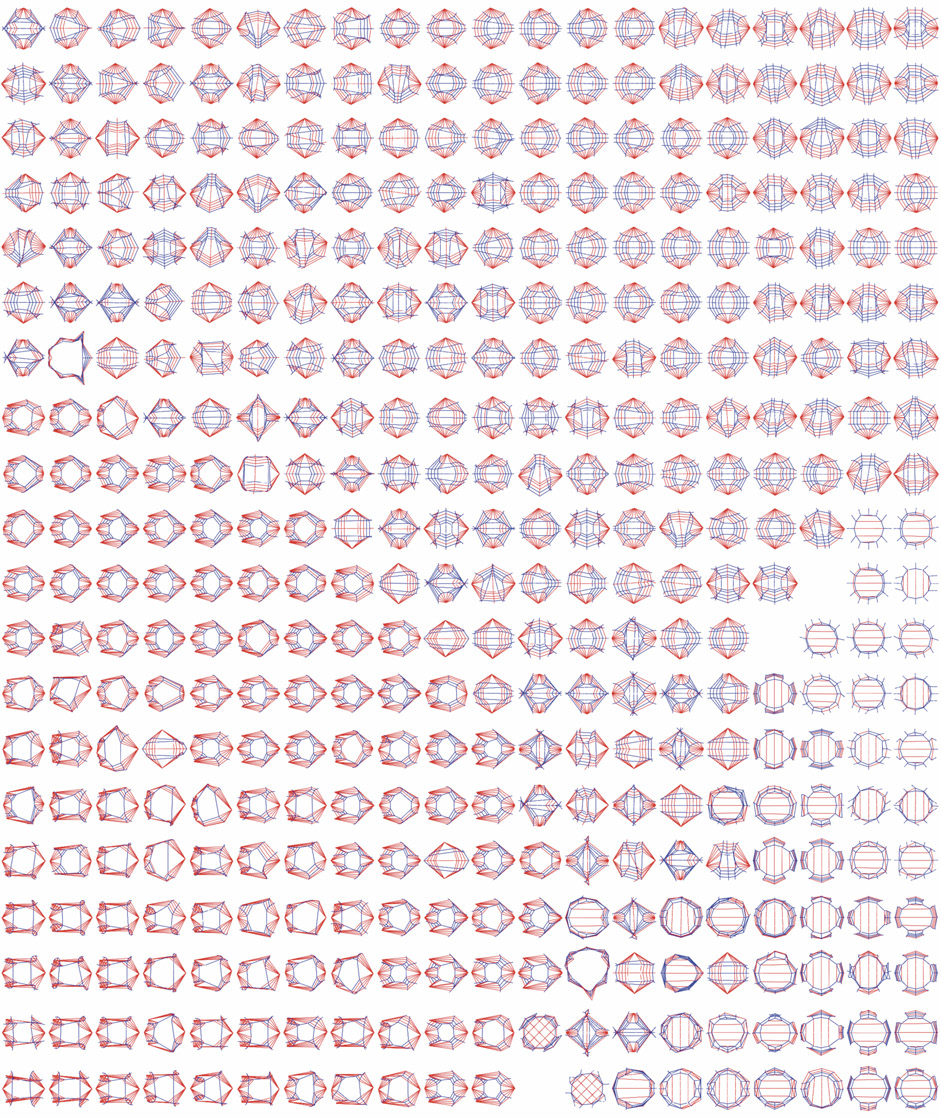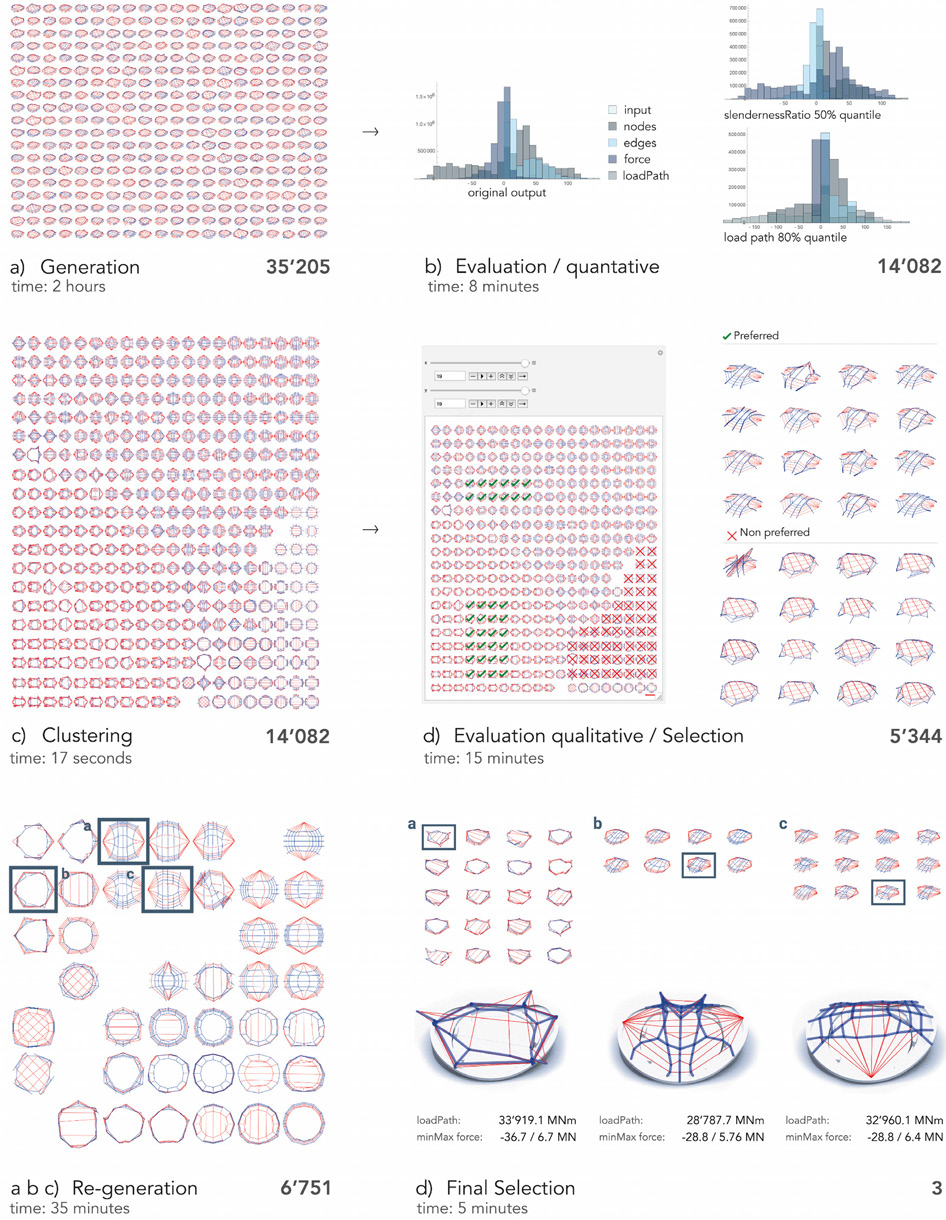
BEYOND TYPOLOGIES, BEYOND OPTIMIZATION
Exploring novel structural forms at the interface of human and machine intelligence
In collaboration with Ole Ohlbrock, Pierluigi D’acunto, and Vahid Moosavi.
This paper presents a computer-aided design framework for the generation of non-standard structural forms in static equilibrium that takes advantage of the interaction between human and machine intelligence. The design framework relies on the implementation of a series of operations (generation, clustering, evaluation, selection, and regeneration) that allow to create multiple design options and to navigate in the design space according to objective and subjective criteria defined by the human designer. Through the interaction between human and machine intelligence, the machine can learn the non-linear correlation between the design inputs and the design outputs preferred by the human designer and generates new options itself. In addition, the machine can provide insights into the structural performance of the generated structural forms. Within the proposed framework, three main algorithms are used: Combinatorial Equilibrium Modelling (CEM) for generating structural forms in static equilibrium as design options, Self Organizing Map (SOM) for clustering the generated design options, and Gradient Boosted Trees (GBT) for classifying the design options. These algorithms are combined with the ability of human designers to evaluate non-quantifiable aspects of the design. To test the proposed framework in a real-world design scenario, the design of a stadium roof is presented as a case study.
In this section, a representative design experiment is used to illustrate the potentials of the proposed structural design framework, and to describe the related operations and the chosen algorithms in more detail. The experiment is placed within a typical structural design task, which consists in the creation of a new roof for the undulating bowl of the Nya Ullevi Stadium in Gothenburg, Sweden.
This paper describes an approach to structural design that tries to go beyond the use of typologies and the sole application of optimization routines. This approach is enabled through the combination of innovative generative methods (Combinatorial Equilibrium Modelling) with state-of-the-art Machine Learning algorithms (Clustering; Self Organizing Map, and Classification; Gradient Boosting Trees) and combined with the ability of humans to evaluate non-quantifiable aspects in a discursive manner. The main objectives of this paper are:
A) To introduce a theoretical and operative structural design framework that allows generating multiple novel, diversified, and structurally informed design options that go beyond the conventional canon of structural typologies;
B) To combine the strengths of human cognition with those of machine-driven computation, in order to bring together the subjective evaluation and selection capacity of humans with the ability of machines to handle large datasets;
C) To introduce a machine-based procedure that allows generating new structural design options by learning the design preferences of human designers.
The research presents a case study for the conceptual design of a stadium roof. This case study demonstrates the potential of the proposed framework, while possibly contributing to the ongoing discussion on the human-machine interaction within the field of structural design. While several of the techniques used in the proposed framework have been presented before, the combination and sequence of these operations can be regarded as the main contribution of this work. Thanks to its flexibility, it is possible to apply the framework to different contexts and various structural design problems.
With the use of fast generative methods, the designer has access to several thousands of design options in a short amount of time. In order to guide the design process, a generative engine is usually coupled to an optimization routine, which searches for optimal solutions for a given set of hard or/and soft constraints, expressed through the definition of objective functions. However, while optimization routines are useful in the final converging stages of the design process, in the conceptual phase, designers cannot rely solely on their application.
14,082 design options were transformed into numerical inputs using the four moments of Higher-Order Statistics (HOS) function of the members’ lengths (mean, variance, skewness, and kurtosis; see section “Clustering”) This dataset of numerical inputs were fed as input into a Self Organizing Map (SOM) with a grid size of20 × 20. A SOM can recognize similar patterns among the data and organize the corresponding options accordingly. The resulting SOM spans over 400 cells or BMUs (see section “Clustering”). The image above displays the design options that are the ones with the closest Euclidean distance to its corresponding BMU value. Therefore, they can be considered representative cases for each cell. The trained SOM can additionally visualize the four moments of HOS displayed below.
All the computational tasks described in this section were performed with a Quad-Core 2.7 GHz CPU with no GPU acceleration. The figures below show an overview of the design experiment and the time required for each design operation and illustrates the renderings of the final selection.
The article introduced a computational design framework for the generation of non-standard structural forms in static equilibrium, which takes advantage of the interaction between human and machine intelligence. The framework is built upon basic design operations such as generation, evaluation, clustering, selection, and regeneration. More precisely, the generative operation is based on CEM for the creation of structural forms in static equilibrium as design options. In the operation of clustering, an SOM is employed to organize and represent the diversity of design options in a comprehensible manner according to a set of design features defined by the human designer (Figure 13). Hence, the organized representation enhances the understanding of the full design space and supports decision-making. In addition, HOS is used to encode the relevant aspects of the generated options with a high level of precision. Finally, the supervised classification algorithm GBT is used for the regeneration of the design options.
Forthcoming
We are currently developing an automatic 3D form generator from input text. If you have time play with our labeler and send us your results to ksaldanaochoa@ufl.edu
Gallery













